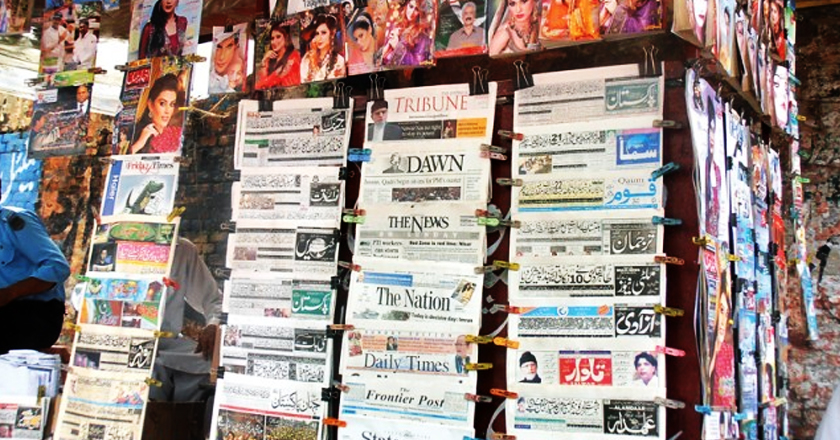
A Pew Research Centre report “State of News Media” states that in ninth straight yearly decline the newspaper revenue has dropped to $ 16.4 billion; one-third to 10 years before, staffing at 34-year low, magazine circulation at 2.2 percent low and all the major news magazines have seen ad pages drop to half since 2001.
Newspapers and magazines are the third largest cultural and creative industry of the world by creating 2.9 million jobs. WAN-IFRA has estimated the industry’s revenue at 8 billion US dollars.
Pakistan is the 10th largest country in the world in terms of print newspaper and magazines circulation.
To meet the demands of future and tackle the possible threat print newspapers like Jang, Nawa-i-Waqt, Express, Dawn, Pakistan and magazines like MORE have launched and activated their digital versions and social media platforms.
Last quarter of 2016 did and first, of 2017 is creating a lot of drama in the United States of America. There can be nothing so compelling than Donald Trump for people around the globe to read The New York Times, a 166 years old credible source of news in America. Although due to this, the newspaper got 275,000 new subscriptions, but the share of the print version of the newspaper in these was less than a quarter. A time that should have been ideal for the Times, its print advertising dropped by 20% and print version failed to collect any profits instead a 9% loss was reported by the New York Time Company’s Annual Report-2016. This gives an important signal, the death of print and the transformation towards digital media.
This transformation touched the USA Today in 2015 when it announced a buyout package for it veteran employees to trim staffing. The newspaper presented cutting costs and investing in digital products as the main reason for the offer. Until now it has shuttered it weekly magazine “USA Weekend” and a number of other publications to remove the employed staff in these departments. A Pew Research Centre report “State of News Media” states that in ninth straight yearly decline the newspaper revenue has dropped to $ 16.4 billion; one-third to 10 years before, staffing at 34-year low, magazine circulation at 2.2 percent low and all the major news magazines have seen ad pages drop to half since 2001.
It was a great journey, though, but it seems as if after 560 years of success, the print is going to die. Today the print media in the US has shrunk itself to only 3 national newspapers. According to the Columbia School of Journalism, in the last five years, 2000 percent increase in the digital transformation has been witnessed and news data of these is amounting to 4 trillion gigabytes.
In the UK, the strongest “Daily Mail” issued a warning to the investors in 2016; when its newspaper division reported a 29 percent decline in profits. Except for newspapers, there is no industry in the US and the UK that has faced such steep decline due to the intervention of digitization. Since the first Intrepid web 1.0 bloggers started writing the news content with SEO headlines, people around the globe have been discussing and forecasting this development. Although papers like The Independent have stopped printing any tangible product, papers somehow are still on the newsstands. Although it looks like a spider is clinging to the web inside a tidal sea but those still surviving are learning the art of nullifying and resisting to the digital revolution.
As per World Press Trends Data, newspapers around the globe generated US$ 168 billion from circulation and advertising in 2015. Out of this 53% (90 billion) was generated from print/digital circulation and the remaining 78 billion from advertising. Newspapers and magazines are the third largest cultural and creative industry of the world by creating 2.9 million jobs. WAN-IFRA has estimated the industry’s revenue at 8 billion US dollars. 2.7 billion adults are reading the print newspapers globally but this ratio is decreasing as according to the same data, 40 percent of the world internet users are reading newspapers online and in many countries digital readers are surpassing the numbers of print readers.
The big questions for today are;
- Will it stop somewhere?
- Will the print be able to find equilibrium with the digital media?
- If so, at what point – half of the present circulations, a quarter?
- Or will the digital media guzzle up the print utterly?
Although, it is too early to predict but the signs of hope are coming from Pakistan, India, China and a part of Europe. According to “Statista”, which provides statistical data on print newspapers’ circulation worldwide, daily print newspaper circulation has increased from 589 million (2010) to 800 million (2016). In Pakistan, it shows that the revenue from print newspaper circulation will rise from the US $ 301 million (2015) to $ 333 million until 2020.
Pakistan is the 10th largest country in the world in terms of print newspaper and magazines circulation. China – 96, 704,000, India – 79,243,139, Japan – 70,446,000, USA – 57,357,000, Germany – 22,100,000, UK – 17,375,000, Russia – 13,280,000, France – 9,890,365, Italy – 8,017,000 and Pakistan – 7,817,958 are the world top countries by print newspaper circulation. But newspaper circulation is not the only determinant of newspaper readers in a country. For example, in a household, a family of 8-10 people buys a single newspaper or magazine only. All of them share this newspaper to read. So in this way, the number of newspaper readers in a country will be many times more than the number of newspaper circulation.
Registrar of the newspapers in India has released a list of 16,000 active newspapers and 94,700 periodicals. 5,400 new publications were added to the list in 2015-16. A total of 610 million copies of print newspapers and magazines were distributed in the country. Bengali language newspaper – Anand Bazar Patrika emerged as the largest circulated single edition daily with 1.15 million copies distributed. In the multi-edition category, Hindi newspaper Dainik Bhaskar topped the list by distributing 6.6 million copies. The largest circulated single edition English daily in India is Hindustan Times with a circulation of 992,000 and in the multi-edition category, The Times of India is at the top with 4.4 million copies distributed.
Now the question here is that why print media in the sub-continent is growing when it is declining in many other parts of the world? The answer is multi-dimensional.
The first and foremost reason to this is the growing population of youth in our region. 63% of Pakistan’s population is below the age of 25 years. India has the world’s largest youth population as 356 million of its population is 10-24 years old despite having a smaller population as compared to China. Compared to China, both Pakistan and India are suffering from corruption, unemployment, terrorism, uncertainty and economic challenges. The enmity between both the nations, the war in Afghanistan and other regional factors are compelling the youth to read newspapers as a source of information. The youth in these countries is highly charged, motivated, vibrant and vigilant regularly following the news stories that affect their future aspirations and goals.
Second reason to this growth is very low internet penetration in these countries. Pakistan, for example, is the 6th largest country in the world by population. Internet penetration in the country is at 17.8% which is just 1% of the total 3,424,971,237 internet users in the world. In India, the situation is quite better but still, internet penetration in the country is at 26%. The countries where the print media is facing troubles like the US, UK, Japan and Australia, internet penetrations are quite high; 74%, 92%, 93% and 84% respectively. Because of this low internet penetration, digital media has not posed a serious threat to print media in Pakistan and India. However, it is expected that with the rise of penetration level, a similar threat may arise in these countries too.
The third important reason is the advertising revenue. While it has fallen for print in the US, UK, Japan and Australia because of continuous fall in print circulation, an exact opposite is present in countries like Pakistan and India. Growing print means more readers; this attracts more advertisements and revenues as well. For this very reason, many online websites are now trying to have a print product as well.
To meet the demands of future and tackle the possible threat print newspapers like Jang, Nawa-i-Waqt, Express, Dawn, Pakistan and magazines like MORE have launched and activated their digital versions and social media platforms. On the other hand, the digital only websites are now trying to copy the print model. In Pakistan, “Pakwheels” and automobile sale/purchase website and “Zameen.com” have launched their magazine followed by “CNet” with a quarterly magazine and Net-o-Porter’s bimonthly magazine. News websites like “Propakistani” are also thinking to present a print product. This web to print conversion is because of the advertising revenue generation capacity in the print media that is very strong and relevant in the countries like Pakistan and India. Digital advertising rates and demand is quite poor and ordinary due to low internet penetration in the country.
While media of the developed world is going digital, we have many reasons to rely on print for the ease it offers in reading and navigation, better information retention, fostered skimming habit, tactility, credibility, health friendly and sustainability. And in our offices, these DPOs, DCOS, EDOs, Clerks and Headmasters all love the print. Our Press Information Department (PID) and Director General Public Relations (DGPR) still rely on print newspaper cuttings.
Digital alone is orphanage here,
So we are defying, print is rising.



